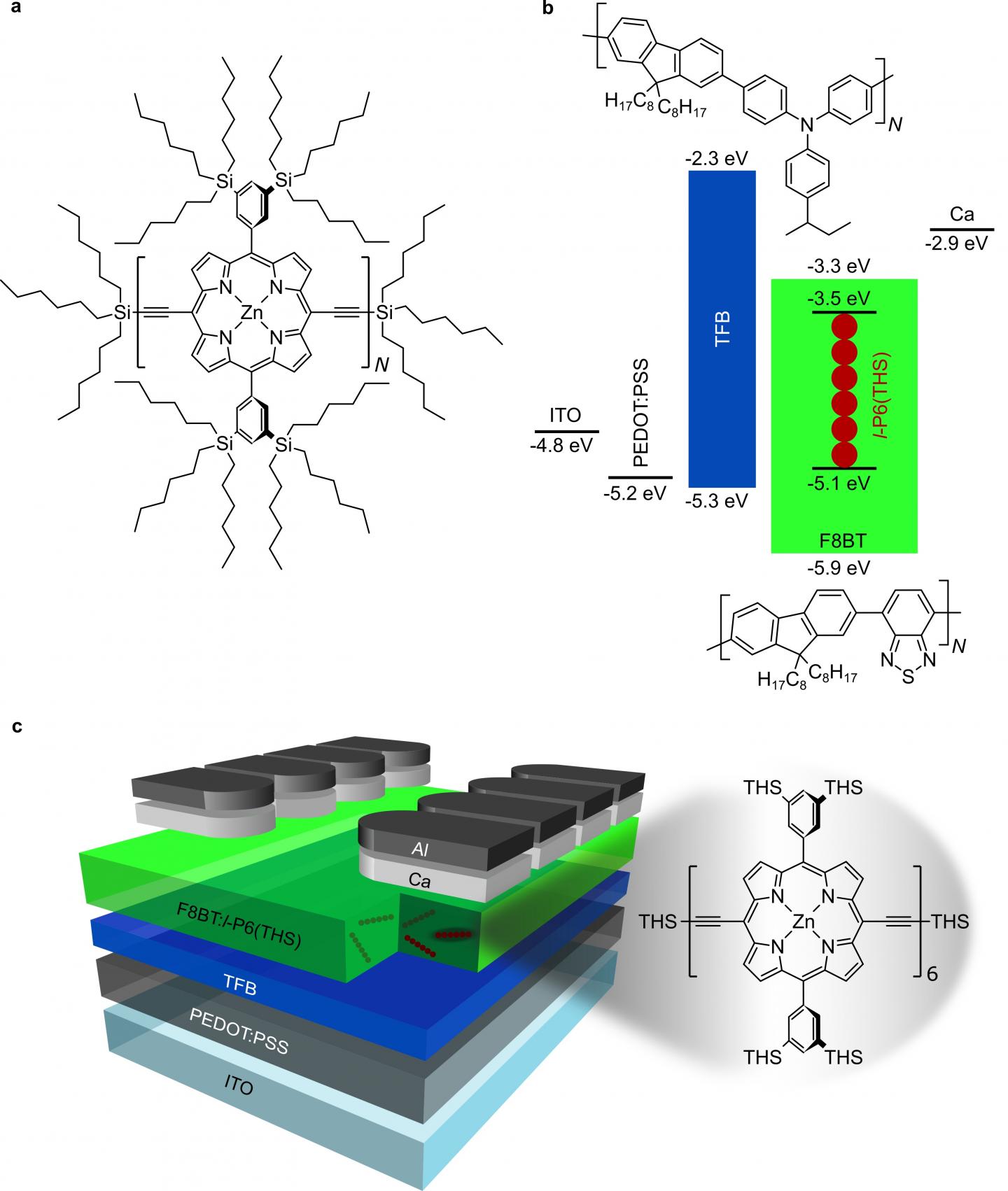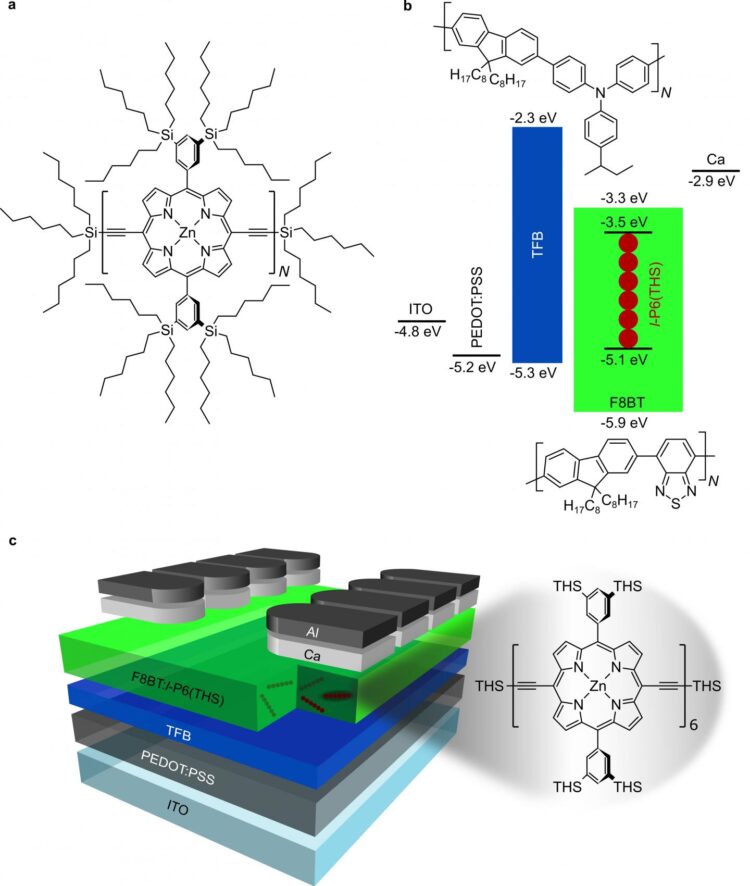
Credit: by Alessandro Minotto, Ibrahim Bulut, Alexandros G. Rapidis, Giuseppe Carnicella, Maddalena Patrini, Eugenio Lunedei, Harry L. Anderson, and Franco Cacialli
The ability to manipulate near-infrared (NIR) radiation has the potential to enable a plethora of technologies not only for the biomedical sector (where the semitransparency of human tissue is a clear advantage) but also for security (e.g. biometrics) and ICT (information and communication technology), with the most obvious application being to (nearly or in)visible light communications (VLCs) and related ramifications, including the imminent Internet of Things (IoT) revolution. Compared with inorganic semiconductors, organic NIR sources offer cheap fabrication over large areas, mechanical flexibility, conformability, and, potentially, bio-compatibility. However, the emission efficiency of organic emitters in the NIR is hindered by the detrimental effects of certain types of aggregation/packing of the emitters in the solid state and by the generally observed increase of non-radiative rates upon reduction of the energy gap (EG), i.e. the so-called “energy-gap law” (EG-law) for radiationless transitions. Hybrid organic/inorganic innovative materials such as perovskite methylammonium lead halide and quantum dots may offer a high external quantum efficiency (EQE) alternative, but their heavy-metal content will prevent their use in most applications, especially biocompatible or wearable ones. Toxicity issues can also affect phosphorescent materials incorporating toxic heavy elements.
In a new paper published in Light: Science & Applications, an international team of scientists, led by Professor Franco Cacialli at University College London and Professor Harry Anderson at the University of Oxford report novel non-toxic and heavy-metal-free organic NIR emitters and OLEDs characterised by emission peaking at ~ 850 nm and a maximum 3.8% external quantum efficiency (EQE).
The authors use optical spectroscopy to elucidate how it is possible to leverage the increasing spatial extent of excited states with oligomer length to favourably manipulate the competition between radiative and nonradiative processes (quantified by the radiative and nonradiative rates, kr and knr respectively), while simultaneously suppressing aggregation. Surprisingly, instead of a decreasing photoluminescence quantum yield (PLQY) with oligomer length (and thus with reducing gap), a steady increase and eventual saturation of the PLQY is observed at around the hexamer (l-P6(THS)). While surprising, this behaviour can be understood by considering that in these systems conjugated triple-bond-based bridges between the porphyrins allow effective intra-molecular electronic coupling among the macrocycles, and so enable the radiative (singlet) excited state (exciton) to delocalize over increasing portions of the molecule. This forces an increasing mismatch of the spatial extent of the radiative (singlet) and of the non-radiative (triplet) excitons, in view of the intrinsically localized nature of the triplets. Such a mismatch is expected to suppress intersystem crossing (ISC) between singlets and triplets and therefore the non-radiative rate (knr). In addition, exciton delocalization is also expected to favour decoupling from vibrational ladders (and thus circumvent the EG-law). Remarkably, the growth of the nonradiative rate as a function of the decrease of the energy gap (forced by the increased oligomer length) is characterized in these systems by a logarithmic rate an order of magnitude smaller than in previous studies. Second, bulky trihexylsilyl side chains are attached to the porphyrins to prevent aggregation quenching, through steric hindrance, which limits π-π interactions (see chemical structure in Figure 1).
The basic photophysics and material design breakthrough has been confirmed by incorporating an F8BT:l-P6(THS) blend in OLEDs, with which an average EQE of 1.1% and a maximum EQE of 3.8% at a peak wavelength of 850 nm were demonstrated (Figure 2). A novel quantitative model was also developed to analyse the results, which implies the importance of triplets to singlets conversion processes (e.g. reverse inter-system crossing, and/or thermally activated delayed fluorescence) to account for the EQE values beyond the apparent limit imposed by spin-statistics.
The EQEs presented in the paper are, to the best of the authors knowledge, the highest reported so far in this spectral range from a “heavy-metal-free” fluorescent emitter.
The authors summarise the significance of their work by saying:
“Not only do our results demonstrate milder increases of knr with (reducing) EG than in the literature, but, most importantly, they also provide a general strategy for designing high-luminance NIR emitters.”
“In the short term, they may enable further development of OLEDs in this challenging spectral range for a wide range of potential applications spanning from the life-sciences (biochemical wearable sensors, in vivo sub-surface bio-imaging, to name just two), security (e.g. biometrics), horticulture, and (in)visible light communications (iVLC), a serious contestant to alleviate the bandwidth demands of the imminent Internet-of-thing (IoT) revolution.”
“More importantly, and in perspective, these findings are significant to a range of disciplines.”
###
Media Contact
Franco Cacialli
[email protected]
Related Journal Article
http://dx.





